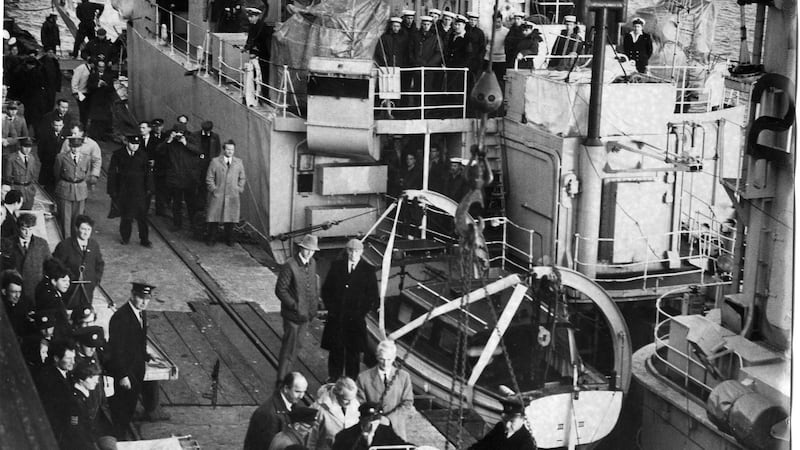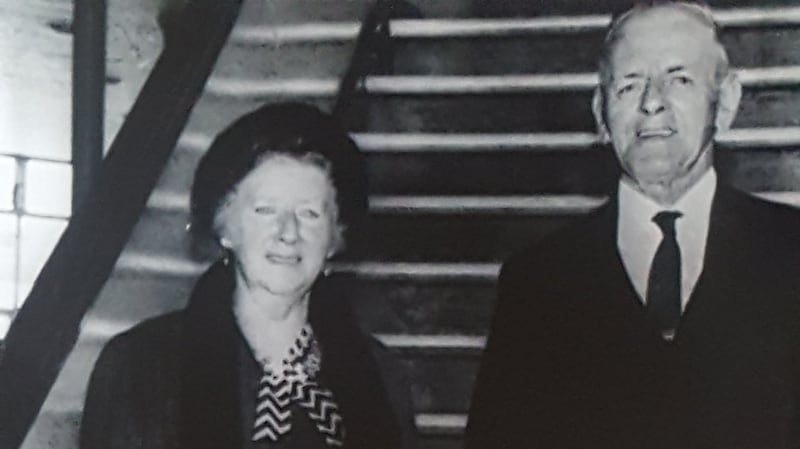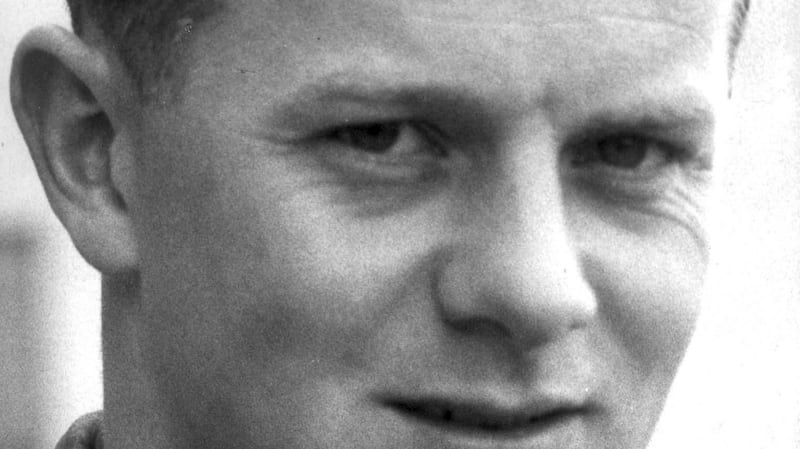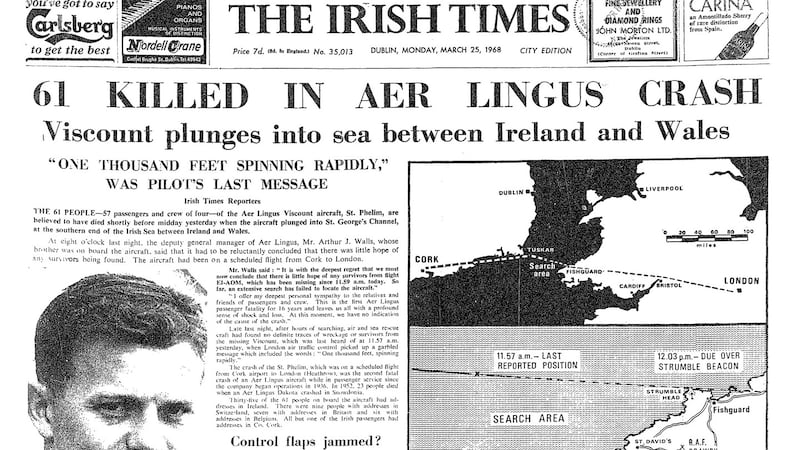"Twelve thousand feet descending spinning rapidly," said a voice from the St Phelim, later assumed to be that of First Officer Paul Heffernan.
Those were the last words London air traffic control – or anyone else – would hear spoken from the plane.
It is 50 years to the day since EI-AOM, Aer Lingus flight 712 – a routine passenger plane bound for London – took off from Cork Airport with 61 people on board.
What happened above Tuskar Rock and in the sea off Rosslare, Co Wexford, will be commemorated today on land and at sea.
No one really knows what occurred to cause the St Phelim to fall out of the sky, killing the 61 on board. Whatever it was, it was sudden and catastrophic.
In the immediate aftermath of the crash, gardaí and the Air Corps, local fishing vessels and lifeboats from Rosslare, Kilmore Quay and Arklow, all searched the sea. Some bodies were found eventually, but just 14 of the 61 dead were recovered.
It was guesstimated that the St Phelim went into a spiral dive, losing height at a rate of 120 feet per second, hitting the sea some 100 seconds later at almost precisely 11am, 1.7 nautical miles due east of Tuskar Rock.
Several people on shore, at various points between Carnsore Point in the south and Greenore Point to the north, heard the plane hit the sea. They spoke of sounds like “a very sharp roll of thunder”, “a very loud whoosh”, “a rumbling sound” and a noise “like water running off rocks”.
A seaman on a passing ship said he caught a fleeting glimpse of an aeroplane falling into the sea, hitting it with a large splash near Tuskar Rock.
Scream
Five-year-old Niall O’Keeffe was back home, playing in the garden. He heard a scream come from inside the house, after RTÉ newsreader Charles Mitchell made an announcement on the radio.

Earlier, he had gone to Cork Airport with other family members to wave off his granny, Bridget O’Callaghan, then in her 70s, and her daughter, Niall’s aunt Hannah, who was in her 40s.
Bridget had her photo taken before boarding the plane. She stands there, husband Michael by her side, a slight smile on her face, an Aer Lingus “Irish Airlines” overnight bag in her left hand.
The body of Bridget was the last to be found (Hannah was, like most others, lost at sea) and she is buried in Blackrock cemetery, Cork.
“My mother regularly takes care of the grave. What happened is never too far from mind,” says O’Keeffe.
Jerome McCormick also remembers going to the airport on Sunday morning, March 24th, 1968 to see off his older brother Neill.
Neill was 15 years Jerome’s senior and he looked up to him for several reasons. Neill (nickname Nux) had played rugby – for Munster and for Sale – and even got a trial for Ireland. He was 35, worked as a consultant and expert in machinery used in the textile industry, and was based in New York.
By the time of the Cork to London flight, it had clocked up many miles – 18,806 flying hours in total and almost 17,000 landings
Today, he will remember his brother – "the heart and soul of the party, with the butt of a cigarette and belting out Won't You Come Home Bill Bailey?"
McCormick accepts what happened was an accident but holds to the view that some airborne object, a military drone or missile, must have hit the St Phelim.

Theories relating to the British military have persisted for five decades, despite the absence of conclusive evidence.
Normal take-off
The Viscount 803 trundled down the runway, a capacity load of four crew and 57 passengers (33 Irish, nine Swiss, six Belgian, five British, two Swedes and two US citizens) on board. The take-off was entirely normal, wheels up at 10.32.
No other planes plying the route ahead of the Viscount filed any reports of significant weather.
The plane was 10½ years old and was built originally for KLM, the Dutch airline. Aer Lingus bought it in November 1966 and, after a thorough overhaul, it went into service in February 1967.
By the time of the Cork to London flight, it had clocked up many miles – 18,806 flying hours in total and almost 17,000 landings.
The pilots were young but experienced. Captain Bernard ‘Barney’ O’Beirne (35) was ex-Air Corps and had 6,683 flying hours under his belt, almost 1,700 of them on Viscounts. First Officer Heffernan (23) had 1,139 flying hours of which 900 were on Viscounts.
Their plane climbed without incident to 7,000ft and Cork air traffic control gave them clearance to head for Tuskar, climbing a further 10,000 feet.

At 10.57:29, O’Bierne and Heffernan were told to switch communications channel to London frequency. Thirty three seconds later, London air traffic control heard a voice. “Echo India Alpha Oscar Mike [St Phelim’s identifying registration, EI-AOM]”.
Wreckage
The main bulk of fuselage wreckage was found lying in 252ft of water and comprehensive examination was not possible until June. Divers from a salvage vessel, Uplifter, assisted by two Royal Navy vessels, examined the wreckage – “a skeleton of transverse ribs, stripped of the skin plating from 5ft above the seabed”, according to a review of all information on the crash, published in 2000.
“The wings were sheared off the fuselage and like the rest of the tangle of wreckage constituting the fuselage proper, the cockpit was open at the top and badly wrecked internally.
“Some bodies were seen within the tangled fuselage frames but the interior was in such confusion with loose wreckage piled here and there, that it was not possible to get a clearly defined aircraft shape from the wreckage.”
None of the dead showed evidence of having breathed in fumes prior to their demise, nor evidence of the effects of combustion. None had drowned.
All, it appeared, were killed by the impact of the crash. Just 14 of the 61 bodies were recovered and they showed “gross damage to most of the vital organs, and severe head and leg injuries”, according to the crash investigation report.
As regards the wreckage, it did not reveal what had happened.
“The indications are that the airframe was substantially intact at impact, with the possible exception of the tail planes and elevators . . . No evidence of structural failure in the aeroplane, nor of pre-impact damage to the airframe of a catastrophic nature has been found. . .” said the report.
Irish roots
In 1968, Steve Gangelhoff was 16 and living in London with his brother Rich and parents, Joseph and Mary Elizabeth. Joseph worked for Conoco, the off-shore energy exploration company; Mary Elizabeth had Irish roots she wanted to explore.
We have no remains to honour, no graveside to visit, nothing to show our children, and eventually our grandchildren
“I remember the day they were leaving London on their trip to Ireland,” says Gangelhoff . “I was standing by our front door as they were dressed and ready to leave, and I said ‘goodbye’.
“The Englishwoman nanny who had been hired to stay with my brother and I for those days noticed that I, the independent rebellious teenager, had not much to say to my parents on their departure. She said ‘aren’t you going to give your parents a hug before they leave?’ So I did.
“I will never forget those last moments with them.”
Sitting on the floor watching TV, the programme was interrupted with the news from Tuskar Rock. There was little doubt in Gangelhoff’s young mind that it was his parents’ plane.

“It’s been unsettling over the years not knowing what exactly happened,” says Gangelhoff . “We have no remains to honour, no graveside to visit, nothing to show our children, and eventually our grandchildren, where their grandparents and great grandparents were laid to rest.
“I’ve had difficulty answering the question over the years: how did your parents die? Most people are stunned to hear the answer . . . Not having that closure leaves something of a hole in one’s heart.”
Gangelhoff’s sister Bonnie, a 21-year-old student in Connecticut at the time, still feels a “profound loss”. Every year she sends flowers to the crash memorial in Wexford and lights a candle.
This weekend, she will go to Mass in Colorado; Steve will do the same in Texas. They will pray for all who died and for the families with whom they share tragic kinship.
“You don’t get over the loss, you only get used to living with it,” she says. “To cope with my loss, I follow my instincts and heart in what feels comforting and a meaningful way to remember my parents. And something about returning to Ireland offers solace.”
Tuskar Rock crash - 50th anniversary events
8.00am: MS Stena Europe and Irish Ferries' MS Isle of Inishmore will drop wreaths at the site of the crash off Tuskar Rock as they sail past.
11.00am: A flotilla, led by the Navel Service vessel LÉ Eithne and carrying relatives of the 61 who died, will escort lifeboats from Rosslare, Kilmore Quay and Arklow, together with fishing boats and other boats from the area, out to sea for a service of remembrance at 12.15pm.
2.30pm: At the memorial park at Crosstown Cemetery where a cenotaph stands with the names of the victims, all 61 will be read, in the presence of Minister of State for Defence and local TD Paul Kehoe, mayor of Wexford Jim Moore; and other dignitaries, among them Swiss ambassador Marie-Claude Meylan, and the Belgian embassy's deputy head of mission Bernadette Scheid.
Also present will be Band 1 Southern Brigade, Cork, (the Army No 2 Band), the Wexford Male Voice Choir, representatives of the Coast Guard, the Order of Malta and the RNLI.
Rescue 117 will conduct a flyover.
The ceremonies have been arranged by a memorial committee comprising John Boyce and his son, Sean, Leo Coy, Michael Delaney, Art Sheil, Eamonn O’Rourke and John Power, a fisherman who took part in the search.







